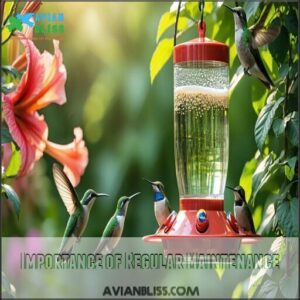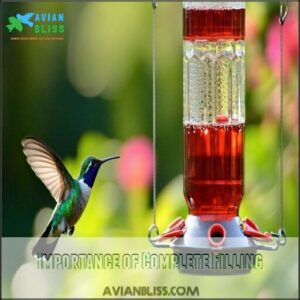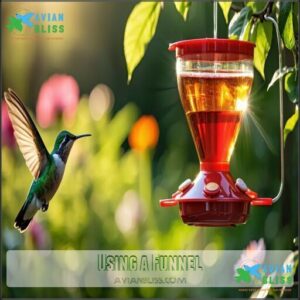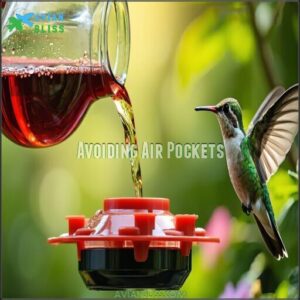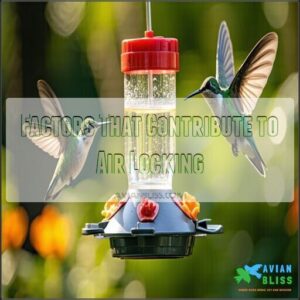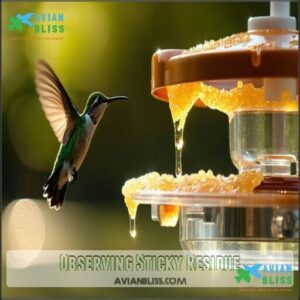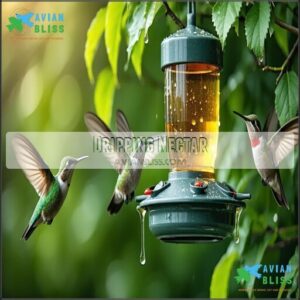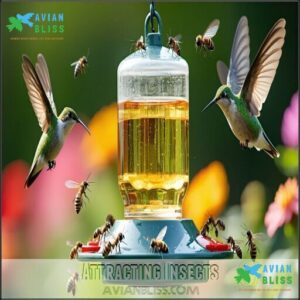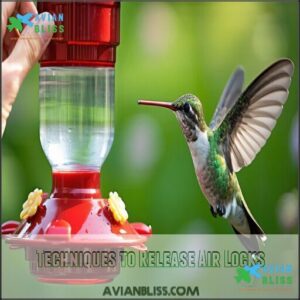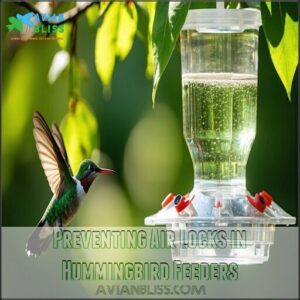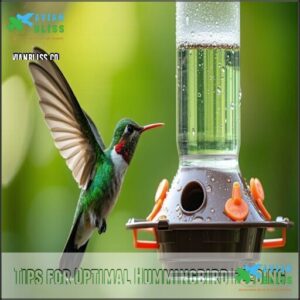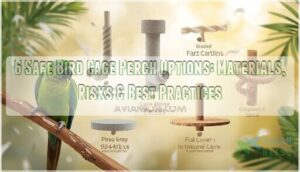This site is supported by our readers. We may earn a commission, at no cost to you, if you purchase through links.
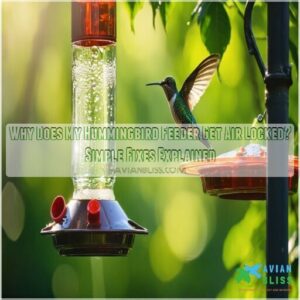 Your hummingbird feeder gets air locked when air gets trapped inside, causing the nectar to stop flowing properly.
Your hummingbird feeder gets air locked when air gets trapped inside, causing the nectar to stop flowing properly.
This often happens due to temperature changes, which make air expand and contract, or if the feeder isn’t filled correctly, leaving space for bubbles to form. Direct sunlight can worsen the issue by heating the nectar, increasing pressure inside.
Poorly sealed or low-quality feeders can also contribute, allowing air to sneak in. To prevent air locks, fill the feeder completely, avoid tilting it too much, and place it in a shaded area.
A saucer-style feeder might also help avoid these hiccups altogether.
Table Of Contents
- Causes of Air Locking in Hummingbird Feeders
- Why Does My Hummingbird Feeder Get Air Locked?
- Importance of Regular Maintenance
- Filling Techniques to Prevent Air Locks
- Choosing The Right Hummingbird Feeder
- Factors That Contribute to Air Locking
- Identifying and Fixing Leaks
- Techniques to Release Air Locks
- Preventing Air Locks in Hummingbird Feeders
- Tips for Optimal Hummingbird Feeding
- Frequently Asked Questions (FAQs)
- Why does my hummingbird feeder have air locks?
- How do you remove air locks from a hummingbird feeder?
- How does a hummingbird feeder work?
- Can you keep air out of a hummingbird feeder?
- Why is my hummingbird feeder leaking?
- Why is my hummingbird feeder clogged?
- Why put aluminum foil around a hummingbird feeder?
- How to get air bubbles out of a hummingbird feeder?
- Why is a hummingbird guarding the feeder?
- How to keep a hummingbird feeder from blowing in the wind?
- Conclusion
Causes of Air Locking in Hummingbird Feeders
Your hummingbird feeder might get air locked due to temperature changes, improper filling techniques, or flaws in the feeder’s design.
These issues disrupt the nectar flow, frustrating both you and your feathery visitors.
Temperature Changes and Pressure
Temperature changes mess with your hummingbird feeder’s internal balance, often causing air locks. When sunlight warms the feeder, the nectar expands, and so does the trapped air, disrupting the feeder’s air pressure.
Sunlight heats your feeder, expanding nectar and trapped air, disrupting flow and leaving your hummingbirds frustrated and hungry.
This creates air bubbles at the feeding ports, which can block nectar flow right when your hummingbirds are hungry! Feeders made of thinner materials or tube-style designs are more vulnerable to these issues.
At higher altitudes, atmospheric pressure changes and lower air density make the problem worse.
- Direct sunlight increases vapor buildup, leading to vapor lock and flow interruptions.
- Cool evenings may offer a short-lived fix, but the cycle restarts daily.
Try placing your feeder in partial shade to reduce heat exposure and maintain consistent nectar flow for your feathered guests.
Incorrect Filling Techniques
Filling your hummingbird feeder too quickly can lead to trapped air pockets, causing an air lock and disrupting nectar flow.
This common issue happens when pouring creates bubbles that block the feeder’s mechanism. To avoid such feeder problems, always use a steady filling speed and a funnel to pour nectar directly, minimizing splashing and air pocket formation.
Never overfill—stop just below the feeding ports to prevent overfilling effects like leaks. If an air lock occurs, try the tilting technique: gently tip the feeder to release trapped air.
By being mindful of filling speed and air pressure inside the feeder, you’ll guarantee hummingbirds can enjoy an uninterrupted feeding experience.
Feeder Design Flaws
If your hummingbird feeder keeps getting air locked, the culprit might be its design. Poor construction can cause air-tightness issues and disrupt the vacuum strength needed for smooth nectar flow.
Over time, inexpensive plastic feeders often warp, leading to leaks and frustrated birds.
Here’s what to look for in a better feeder design:
- Sturdy materials like glass provide durability and resist warping.
- Wide openings make cleaning easy and prevent buildup.
- Tight-fitting seals maintain the vacuum needed for consistent nectar flow.
- Saucer-style designs prevent air bubbles from clogging feeding ports.
- Quality valve mechanisms keep the nectar flowing without interruption.
Investing in a well-designed hummingbird feeder is a simple solution, bringing happier birds and fewer headaches. Addressing issues such as bees at the feeder can further enhance the feeding experience.
Why Does My Hummingbird Feeder Get Air Locked?

Your hummingbird feeder gets air locked because changes in temperature, sunlight exposure, and air bubbles interfere with the nectar flow.
Understanding these factors helps you keep the feeder working smoothly, so your feathered visitors don’t go hungry.
This understanding is crucial for maintaining a smoothly working feeder.
Expansion and Contraction of Air
Your hummingbird feeder’s air lock issues often stem from temperature effects causing air expansion and contraction.
As the day heats up or cools down, feeder air pressure fluctuates, disrupting nectar flow.
Here’s how it works:
- Morning cool air contracts, creating a vacuum that limits nectar access.
- Rising midday heat makes air expand, pushing nectar out or clogging ports.
- Evening cooling cycles restart the pressure imbalance, frustrating you and the hummingbirds.
- If you’re at higher altitudes, lower atmospheric pressure magnifies these problems.
Choosing the right feeder material and addressing vapor lock can help maintain steady feeding conditions.
Direct Sunlight on Feeders
Direct sunlight on your hummingbird feeder works like a magnifying glass, intensifying heat and causing air expansion that disrupts feeder air pressure and nectar flow.
This can create air lock issues while accelerating nectar overheating and algae growth, which block feeding ports.
- Feeder Placement: Keep feeders in shaded locations, like under trees or eaves, to protect them from sunlight intensity.
Materials matter—plastic expands more than glass, worsening seal issues.
Proper placement reduces temperature swings, maintaining steady feeder performance and avoiding common feeder problems like air locks.
Bees can also be an issue, so consider bee-proof feeder designs to avoid attracting them.
Air Bubble Formation
Air bubbles can sneak into your hummingbird feeder, quietly causing air lock and feeder problems.
These bubbles form when warm air expands, then contracts as it cools, disrupting the nectar flow. Bubble causes include surface tension changes, feeder angle, and nectar viscosity.
Hummingbirds’ slurping can create tiny vacuums, drawing air into feeding ports.
To prevent this, keep nectar levels steady, gently tap the feeder to release trapped bubbles, and consider saucer-style feeders for easier feeder troubleshooting and fewer bubble dynamics to manage.
Importance of Regular Maintenance
Keeping your feeder clean and in good shape guarantees a steady nectar flow, preventing air locks and blockages.
Regular maintenance also keeps mold and pests at bay, making it safer and more inviting for hummingbirds.
Cleaning to Prevent Blockage
Neglected feeders can quickly turn into troublemakers, causing annoying air locks and disrupting nectar flow. Cleaning your hummingbird feeder regularly is the key to avoiding these frustrating feeder problems. Residue removal, mold prevention, and a little extra care go a long way.
Here’s how you can keep things running smoothly:
- Frequency Matters: Clean the feeder every 2-3 days, especially in hot weather, because sugar crystals form faster and clog feeding ports.
- Brush Types: Use specialized brushes and pipe cleaners to reach tiny areas like vents and breather holes. These tools are lifesavers for feeder troubleshooting.
- Cleaning Solutions: Soak disassembled parts in warm, soapy water to loosen stubborn residue. Skip harsh chemicals that might harm birds.
- Drying Counts: Before reassembly, make certain all parts are completely dry. Trapped moisture can encourage mold, leading to blockages.
Paying attention to often-overlooked areas, especially tiny breather holes, keeps your feeder working like a charm and your hummingbirds happy!
Inspecting Seals and Gaskets
Small issues with seals and gaskets can cause big feeder problems, including air locks.
These components guarantee proper nectar flow and prevent leaks, but they need regular attention.
Here are four tips to keep them in shape:
- Check for Seal Material Degradation: Inspect monthly for cracks, warping, or hardened areas that disrupt the gasket pressure balance.
- Test for Leaks: Fill your feeder with water and watch for drips—tiny leaks contribute to feeder vacuum lock.
- Clean Residue: Use a soft toothbrush with warm water to remove sticky sugar from sealing surfaces.
- Apply Food-Grade Silicone: Seal tiny leaks, but don’t overdo it.
Always keep spare seals handy—finding damaged gaskets during peak season can ruin your day! Consider purchasing replacement feeder seals for future use.
Preventing Mold Growth
If your hummingbird feeder isn’t working as it should, mold might be part of the problem.
Mold doesn’t just spoil nectar; it can also harm hummingbirds and trigger air lock issues.
Clean your feeder every 2-3 days, especially in summer, using cleaning solutions like white vinegar or hot water.
Skip harsh chemicals; hummingbirds are sensitive, and simple solutions do the trick.
Choose feeder materials wisely—glass is more durable and easier to clean than plastic.
Location impacts nectar freshness, so hang your feeder in a shaded area to reduce sunlight exposure, which speeds up spoilage.
Stick to the reliable 1:4 sugar-to-water ratio and refrigerate extra nectar.
These habits guarantee happy hummingbirds and a mold-free, smoothly functioning feeder.
Filling Techniques to Prevent Air Locks
When filling your hummingbird feeder, small air pockets can easily form and disrupt nectar flow.
To prevent this, fill the feeder completely, use a funnel for precision, and tilt it gently to avoid trapping air, which is a key step to ensure smooth nectar flow.
Importance of Complete Filling
Ever wondered why your hummingbird feeder isn’t working or keeps dripping? One culprit could be improper filling, causing trapped air and air locks.
To minimize air and guarantee proper nectar displacement, always fill your feeder completely, as partial fills allow air pockets to form. Pour the nectar slowly, eliminating gaps that could disrupt flow and reduce spoilage.
- No air bubbles visible in the reservoir.
- Liquid fully covers feeding ports.
- Even nectar levels throughout the feeder.
- Smooth tilt flow without interruption.
Complete filling pays off with happier hummingbirds and less maintenance for you—win-win!
Using a Funnel
A funnel makes filling your hummingbird feeder smooth, simple, and airlock-free. Choose the right funnel size—it should fit snugly into the feeder’s opening to prevent spills and wasted nectar. Look for funnel material like silicone or sturdy plastic since these are durable and easy to clean.
Angle matters too! Hold the funnel at a steady funnel angle to control the flow while you pour nectar. A narrow spout shape guarantees precision, avoiding bubbles that eventually cause air locks.
Pour slowly—rushing can trap air, disrupt nectar flow, and leave your feeder dripping. Many prefer to use a specialized feeder funnel for this task.
Don’t have a funnel? A clean plastic water bottle top works as a clever substitute. Always wash your tools to keep them hummingbird-ready!
Avoiding Air Pockets
When filling your hummingbird feeder, air pockets can sneak in, causing air locks that disrupt nectar flow.
The good news? You can outsmart them with a few clever tricks.
Start by pouring slowly—rushing creates bubbles that lead to blockages. Hold the feeder at an angle during filling (aka proper tilting) so air escapes naturally. This way, nectar settles smoothly without trapping stubborn bubbles.
Spotting bubbles? Gently tap the feeder or give it a quick shake to release them before they become a problem. Also, check breather holes periodically; even tiny clogs can disrupt flow.
For lasting results, here’s a simple plan:
- Proper Tilting: Angle your feeder while filling to help avoid air pockets.
- Filling Speed: Pour nectar slowly for better results.
- Settling Nectar: Tap or shake the feeder to remove bubbles.
Careful filling guarantees smooth feeding and keeps air lock headaches at bay!
Choosing The Right Hummingbird Feeder
Choosing the right hummingbird feeder can make a big difference in preventing air locks and keeping your nectar flowing smoothly.
Look for high-quality materials, tight-fitting seals, and an easy-to-clean design to guarantee both you and the hummingbirds enjoy a hassle-free experience.
High-Quality Materials
When your hummingbird feeder starts misbehaving—leaking, air locking, or just creating a sticky mess—poor materials are often the culprit.
Durable construction makes all the difference. Sturdy materials like glass or UV-resistant plastics hold their shape better, resist warping, and last through seasons of sun and weather.
Glass feeders, while heavier, are simple to clean, don’t degrade in sunlight, and prevent warping. Plastic feeders with UV protection are lightweight and maintain their color without cracking. High-quality metal components with rust-free coatings also add to the feeder’s longevity and stability.
Here’s why it matters:
- Better rust resistance.
- Stronger seal quality.
- Easier nectar flow and fewer air locks.
- Simpler cleaning process.
- No leaks or feeder design flaws.
Seal Integrity
Nothing ruins your feeder faster than bad seals. Tightfitting seals are the unsung heroes that preserve vacuum strength, stopping leaks and air locks.
When these seals fail, pressure balance breaks, letting air sneak in and block nectar flow.
Start by checking the gasket material—food-grade silicone is best. It stays flexible in all weather, unlike seals that harden or crack over time.
If you’ve noticed sticky residue or leaks around the ports, it’s a sign the seal’s gone bad.
Here’s your quick checklist:
- Seal Hardening: Aging seals stiffen, losing their tightness.
- Leak Prevention: Leaks usually mean your seal needs replacing.
- Feeder Solutions for Air Locks: Swap brittle O-rings with fresh ones for proper fit.
Keeping seals healthy keeps your feeder stress-free! Many prefer feeders with wide mouth designs for easier cleaning.
Easy Cleaning Design
A hummingbird feeder not working often ties back to its design—cleaning it should feel effortless, not like solving a puzzle.
Choose a feeder with a wide mouth, smooth surfaces, and minimal parts.
These features simplify maintenance and reduce air lock risks.
Disassembly ease is key; the fewer parts, the quicker the clean-up.
Opt for feeders made from dishwasher-safe materials to save time.
Avoid narrow ports or complex tube designs—they trap debris, block nectar flow, and create cleaning headaches.
Instead, make certain brush accessibility for those hard-to-reach areas.
Reliable material choice can prevent cracks or leaks.
Component simplicity matters too.
A quick rinse and scrub with a bottle brush can keep your feeder in top shape, guaranteeing happy hummingbirds.
Factors That Contribute to Air Locking
Air locks in your hummingbird feeder can happen because of weather changes, improper assembly, or other small but impactful factors.
Understanding these issues helps you prevent frustrating blockages and keep nectar flowing smoothly, which is crucial for the hummingbirds’ health and your enjoyment of watching them.
Atmospheric Pressure Changes
Atmospheric pressure changes can subtly stir up air locks in your hummingbird feeder.
Shifts in barometric pressure, especially at higher altitudes, disrupt the pressure balance and trigger vacuum pressure.
Here’s how to manage it:
- Keep nectar levels steady to maintain a consistent seal.
- Place feeders in areas shielded from extreme weather patterns.
- Check for tiny air bubbles regularly, as these can disrupt the flow instantly.
Hot Weather Conditions
Hot weather can turn your hummingbird feeder into a science experiment.
Rising temperatures lead to nectar expanding, triggering air locking and messy vapor buildup. Plus, hot days speed up Nectar Fermentation and spoilage, which hummingbirds avoid.
Combat these challenges with a few tricks:
- Choose shaded placement to keep nectar cool and slow Evaporation Rates.
- Commit to frequent refills with fresh, cool nectar to prevent blockages.
- Invest in heat-resistant feeders, like glass models, that hold up better under temperature changes.
These steps guarantee a flow-ready feeder, keeping your winged visitors coming back, despite the summer heat.
Improper Assembly
Improper assembly can quickly create an air lock in your hummingbird feeder, leaving nectar trapped and frustrating your flying visitors.
Loose parts, seal misplacement, or even missing components can lead to trouble. If valves don’t fit snugly or the feeder’s orientation is off, you’ll encounter leaks and air bubbles that disrupt flow.
Feeder design flaws, like poorly aligned threads, can worsen matters. Always double-check connections and make certain seals are intact to keep your hummingbird feeder working smoothly—small adjustments can make a big difference and avoid messy fixes.
Birds also use visual cues to coordinate movements.
Identifying and Fixing Leaks
Leaks in your hummingbird feeder can cause sticky residue, attract insects, and lead to dripping nectar that wastes food.
By checking for cracks, worn seals, or loose parts, you can quickly pinpoint and fix the problem to keep your feeder working smoothly, which is essential for maintaining a hummingbird feeder.
Observing Sticky Residue
Sticky residue on your hummingbird feeder isn’t just inconvenient—it’s a sign something’s off. That sugary buildup forms when nectar leaks due to worn seals, tiny fractures, or improperly aligned parts, and it’s a magnet for pests like ants or bees.
Left unchecked, it can clog ports, impact nectar flow, and even cause air locks. To keep your feeder in top shape, clean it thoroughly every 2-3 days.
Focus on areas prone to buildup, like seams and ports, and inspect for damage or misalignment. Replace seals and gaskets if they’re cracked or stiff. Remember, a clean feeder isn’t just about appearances—it protects bird health by preventing spoiled nectar and reducing exposure to harmful bacteria.
Follow these critical maintenance tips:
- Check seals and gaskets for leaks.
- Spot clean sticky areas after every use.
- Avoid overfilling to reduce spills.
- Store spare parts for quick fixes.
Dripping Nectar
Dripping nectar isn’t just messy—it’s a beacon for pests and wasted sugar water.
Common culprits include loose seals, warped feeder parts, and improper setup.
Here’s a quick breakdown to fix it:
| Problem Area | Symptom | Solution |
|---|---|---|
| Base seal | Slow, steady drips | Tighten or reseal |
| Feeding ports | Persistent leaking | Replace worn parts |
| Rim or container | Overflowing nectar | Lower fill level |
| Feeder placement | Drips when hung | Adjust feeder angle |
Check feeder angles, monitor nectar viscosity, and inspect parts for material expansion to prevent persistent leaking and ensure a proper feeder setup.
Attracting Insects
Pesky insects love hummingbird feeders, and their sweet nectar can quickly become a dinner invitation for ants, bees, and other pests.
This often triggers feeder problems, like air locks or even your hummingbird feeder not working properly. Thankfully, there are simple ways to keep unwanted guests away.
- Use Ant Moats and Bee Guards: These inexpensive tools create barriers ants or bees can’t cross, protecting the feeder while staying humane.
- Inspect for Issues: Cracks, sticky residue, or trapped air often attract pests. Regular cleaning and repair guarantee nectar stays pest-free.
- Place Strategically: Hang feeders away from plants or flowers, adding Squirrel Baffles to prevent critters from joining. Choose shaded spots to slow nectar spoilage.
Stay consistent and watch pests disappear!
Techniques to Release Air Locks
If your hummingbird feeder gets air locked, don’t worry—it’s a common issue with simple fixes.
You can gently shake the feeder, adjust the nectar level, or use a small needle to release trapped air bubbles and restore smooth nectar flow.
Gently Agitating The Feeder
If your hummingbird feeder’s flow stalls, gentle motion can be a quick fix.
Agitation benefits stuck feeders by dislodging air bubbles that block nectar flow. Here’s how to do it without spilling or causing a mess:
- A Firm Shake: Secure the feeder and lightly shake it. Imagine waking it up from a nap—it helps kick-start the flow.
- Swirling Slowly: Rotate in a circle like you’re stirring tea. This subtle disturbance helps release trapped bubbles.
- Tapping Lightly: A few soft knocks on the base can free obstructions without damaging the feeder.
- Tilting with Care: Gently tip side-to-side to realign the nectar.
Frequency matters; occasional checks guarantee hummingbirds enjoy frustration-free feeding.
Adjusting Liquid Levels
Managing the liquid levels in your hummingbird feeder is vital to preventing air locking and keeping nectar flowing smoothly.
Overfilling can increase nectar expansion volume, causing pressure buildup, while underfilling disrupts the vacuum hummingbirds rely on. Aim for optimal fill levels to balance airflow and nectar availability.
When trapped air or uneven levels block nectar ports, gently tilting or shaking the feeder can clear the obstruction. A quick adjustment like this guarantees your visitors won’t leave thirsty!
Here’s a simple guide to common issues and fixes:
| Problem | Cause | Adjustment | Outcome |
|---|---|---|---|
| Slow nectar flow | Underfilled feeder | Add more nectar | Steady feeding |
| Air locking | Uneven liquid levels | Tilt to redistribute liquid | Free nectar flow |
| Blocked ports | Old nectar buildup | Clean and refill | Fewer feeding disruptions |
| Overfilled feeder | Pressure buildup | Remove excess nectar | Balanced flow |
| Frequent air locks | Poor filling techniques | Monitor nectar more closely | Better performance |
Regularly checking levels protects feeders from evaporation rate impact, altitude considerations, and nectar waste.
Using a Needle to Remove Air Bubbles
Air locking in your feeder caused by air bubbles? A simple needle technique can help.
With care and safe practices, you’ll restore your feeder in no time:
- Bubble Location: Spot air bubbles in ports or visible nectar areas.
- Needle Size: Use a small, sterilized sewing needle for precision.
- Feeder Material: Gently puncture bubbles on plastic but avoid damaging glass.
- Alternative Tools: If unsure, try a toothpick instead of a needle.
- Improved Flow: Tap the feeder lightly to release residue traps.
Your hummingbirds will relish the smooth flow—problem solved!
Preventing Air Locks in Hummingbird Feeders
You can prevent air locks in your hummingbird feeder by placing it in a shaded area, using a saucer-style design, and regularly checking nectar levels.
These simple steps guarantee a steady nectar flow, keeping your hummingbirds happy and well-fed.
Placing Feeders in Shaded Areas
Keeping your hummingbird feeder in shaded areas is one of the easiest feeder solutions for air locking.
Direct sun exposure heats the nectar, leading to temperature changes that cause trapped air bubbles and disrupt nectar flow.
Instead, pick a spot under a tree or porch—somewhere shaded but visible to birds.
Shade also keeps nectar fresh longer, which means you’ll spend less time refilling spoiled sugar water.
It’s about temperature control—cooler environments reduce pressure and stop air lock issues before they start.
Place your feeder about five feet off the ground in low-traffic zones, away from pets.
A little sunlight is fine to attract bird activity, but too much spoils nectar faster.
Proper placement guarantees fewer headaches and happier hummingbirds buzzing around, ensuring a better experience with happier hummingbirds and less air lock issues.
Using a Saucer-Style Feeder
Switching to saucer-style feeders can save you a ton of headaches when dealing with hummingbird feeder issues like air locks and nectar flow disruptions.
Saucer-style feeders simplify maintenance and eliminate air locks, ensuring happy hummingbirds and hassle-free feeding for bird lovers.
These feeders rely on a simple design that eliminates air pressure problems caused by traditional vacuum-style feeders.
Here’s why saucer-style feeders are a game-changer:
- Saucer Advantages: No air locks to stress about, thanks to the open shallow nectar basin.
- Cleaning Saucers: Smooth surfaces mean quicker, easier cleaning and maintenance.
- Ant Deterrents: The low profile discourages pests while keeping hummingbirds happy.
- Saucer Placement: Their compact shape makes hanging them in shaded, safe spots a breeze.
Unlike conventional feeders, these reduce leaks, simplify cleanup, and keep nectar levels steady.
It’s a practical upgrade that guarantees your yard stays a hub for hummingbird activity, minus the air lock drama!
Regularly Checking Nectar Levels
Consistency is your best friend in maintaining a smooth experience and keeping hummingbirds happy. Check your hummingbird feeder’s nectar levels daily, especially during hot weather, to prevent issues like sugar crystallization, feeder spoilage, or air locks.
Evaporation and high temperatures can disrupt nectar flow, causing frustration for both you and your visitors. Aim to fill the feeder about three-quarters full, avoiding overflows that can lead to feeder leaking or blockages.
Monitor consumption to guarantee you’re replacing old nectar before it spoils—fresh nectar keeps hummingbird visits frequent. Regular checks help you spot potential hummingbird feeder issues early, facilitating smooth operation and maintaining the magic of uninterrupted hummingbird watch parties.
Tips for Optimal Hummingbird Feeding
You can keep your hummingbird feeders working smoothly by placing them in shaded areas and moving them occasionally to prevent wear.
Having spare parts ready and using a food-grade silicone sealant can also help maintain a steady nectar flow without interruptions.
Moving Feeders Periodically
Relocating your hummingbird feeder every few weeks helps tackle common issues like air locks, feeder leaking, and trapped air while keeping your setup effective.
New locations can make a big difference in Attracting Birds and deterring pests like ants or bees.
- Place feeders in shaded areas to prevent nectar from spoiling.
- Avoid heating issues by moving feeders away from direct sunlight.
- Use plant relocation to create an inviting space near flowers.
- Switch spots to reduce territorial squabbles and keep hummingbirds happy, which is key to maintaining a happy environment.
Keeping Spare Parts Handy
Your feeder’s not invincible, but you can keep it running smoothly with a few spares on hand.
When you notice leaks, clogs, or air locks, quick fixes often save the day.
Here’s your must-have list:
- Gasket Replacements & Valve Mechanisms: These tackle seal maintenance issues, preventing air pressure mishaps and ensuring vacuum pressure stays balanced.
- Port Brushes & Backup Tubes: Unclog nectar pathways and remove air bubbles caused by blockages, prolonging feeder longevity.
- Screws & Emergency Repair Kits: Salvage a feeder stuck shut or fix loose pieces creating air flow disruptions.
For emergency repairs, spare parts guarantee quick solutions.
And remember—choosing tight-sealed feeders with wide mouth reservoirs reduces problems down the line.
It’s your hummingbirds’ insurance policy!
Using a Food-Grade Silicone Sealant
Got leaks or air locks in your hummingbird feeder? A food-grade silicone sealant might be your secret weapon. It’s safe, effective, and keeps nectar running smoothly.
Here’s how to use it for exceptional results:
- Clean thoroughly: Remove any old residue, mold, or moisture.
- Apply sparingly: Use a thin layer along threads, seams, or small cracks.
- Cure completely: Let it set for 24 hours before refilling the feeder.
Stick to sealant labeled “food-grade” to protect your tiny visitors. You can find a variety of options online.
This simple step boosts seal integrity, prevents mold, and extends the feeder’s lifespan. It’s a no-nonsense, long-lasting feeder solution your hummingbirds will definitely appreciate!
Frequently Asked Questions (FAQs)
Why does my hummingbird feeder have air locks?
Air locks happen when temperature changes cause nectar to expand or contract, creating bubbles that block flow.
Direct sunlight, clogged breather holes, or improper filling techniques also play a role.
Tilt gently to release air.
How do you remove air locks from a hummingbird feeder?
Think of air locks as the feeder holding its breath.
Gently tap or tilt the feeder to release trapped bubbles.
Make sure breather holes are clear, refill correctly, and avoid overheating by placing it in shade.
How does a hummingbird feeder work?
Hummingbird feeders use a combination of gravity and vacuum pressure to dispense nectar.
As the birds drink, pressure changes release small amounts of nectar, keeping the flow steady while preventing spills and contamination.
Can you keep air out of a hummingbird feeder?
Stopping air in feeders is like sealing a soda bottle—fill completely, avoid overfilling, and tighten seals.
Keep breather holes clear, prevent leaks, and reduce sun exposure to prevent air locks from forming, which is a complete concept to ensure the feeders work properly.
Why is my hummingbird feeder leaking?
Your feeder might leak due to overfilling, loose seals, or direct sunlight heating the nectar.
Make certain seals are tight, place it in the shade, and avoid tipping it during refills to minimize spills.
Why is my hummingbird feeder clogged?
Your feeder might be clogged due to sugar crystallization, mold, or debris blocking the ports.
Regularly clean it with warm water, a brush, and check for any buildup.
Clogged ports frustrate hungry hummingbirds—and nobody wants that, it’s a situation that can be prevented with proper maintenance of the feeder.
Why put aluminum foil around a hummingbird feeder?
Wrap aluminum foil around your feeder to reflect sunlight like a shield.
This helps keep nectar cooler, reducing spoilage and minimizing air locking.
Plus, it deters pesky ants, keeping your hummingbirds’ dining experience hassle-free, and this is a great way to provide a better hummingbirds environment.
How to get air bubbles out of a hummingbird feeder?
Tilt the feeder gently to let air bubbles escape or tap it lightly to dislodge trapped air.
Verify breather holes are clear, and fill it completely while avoiding overfilling to prevent future bubble issues.
Why is a hummingbird guarding the feeder?
A hummingbird guarding your feeder is defending its food source.
They’re territorial, especially when nectar is limited.
Adding more feeders in separate spots can reduce conflict and keep your tiny visitor from feeling overly protective.
How to keep a hummingbird feeder from blowing in the wind?
Anchor your feeder securely using hooks, wires, or bungee cords.
Choose a sheltered spot, like near trees or walls, to reduce wind exposure.
Weighted bases or stabilizers can also keep it steady during gusts.
Conclusion
Air locks in your hummingbird feeder can feel as stubborn as a jar lid that just won’t budge.
But with simple tweaks—like filling your feeder completely, keeping it shaded, and inspecting for leaks—you can keep nectar flowing smoothly.
Understanding why your hummingbird feeder gets air locked, whether from temperature shifts or design flaws, helps you stay ahead of the problem.
Choose high-quality feeders, regularly check seals, and avoid air pockets to guarantee your backyard becomes a hummingbird haven with a smooth nectar flowing system.


